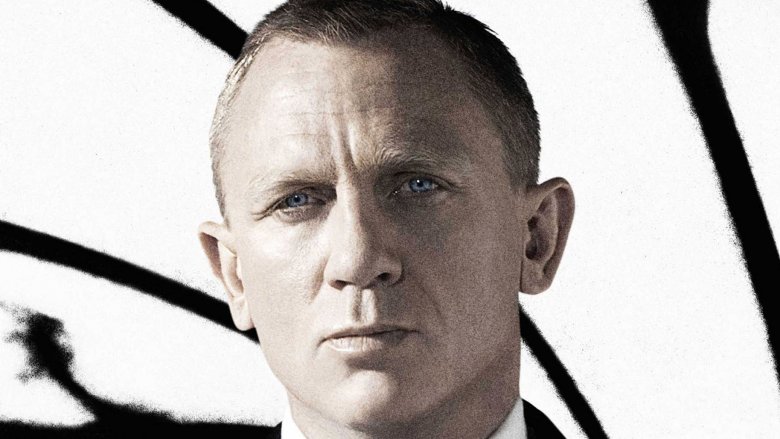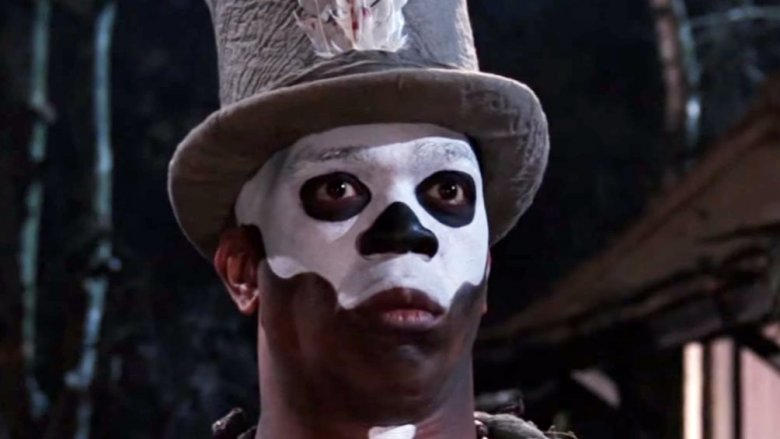The Most Terrible Things James Bond Has Ever Done
James Bond is a raging alcoholic, a notorious womanizer, and a professional killer with a body count in the hundreds. It's no surprise that he isn't a very good person. It is surprising, however, just how low Britain's biggest hero is willing to go.
Over the course of dozens of films, the 14 original novels, and countless other spinoffs, Bond has forced himself on women, brutally murdered allies and villains alike, and mangled one of the world's simplest and most accessible cocktails. And yet, for some people, James Bond is a role model. If that describes you, reevaluate your priorities. You really, really don't want to follow in 007's footsteps.
He 'forcefully seduced' Pussy Galore
In many ways, Pussy Galore is the prototypical Bond girl. Honor Blackman, the woman who played her in Goldfinger, is appropriately stunning. Her name is a not-so-subtle double entendre. She's strong, feisty, and capable, but turns into a pussycat when 007 targets her with his masculine charms. Finally and most unfortunately, like many women both before and after her, Pussy Galore suffers from sexual assault at James Bond's hands.
Watch the love scene between Bond and Pussy, and try to ignore John Barry's playful score. Bond makes a pass at Galore, and she says "I'm not interested." Pussy heads for the exit, and Bond grabs her by the arm. After Pussy says no again, James pulls her away from the door. Pussy tosses James to the ground and tells him to leave. He responds by attacking her, throwing her to the floor, climbing on top of her while she unsuccessfully tries to push him away, and only gives in after James overpowers her and plants a kiss on her lips. The hanky-panky that follows is supposed to be consensual, but let's face it: that's a rape disguised as playful flirting.
If you know Pussy Galore's backstory, it's even worse. In Ian Fleming's original Goldfinger novel, Pussy Galore lost interest in men after her uncle abused her as a teen, and her "Flying Circus" (a group of pilots in the movie, acrobats-turned-thieves in the book) is made up of lesbians like herself. She's "cured" of her condition, of course, when Bond takes her to bed. Unlike the book, the Goldfinger film never outright says that Galore is homosexual, but it's heavily implied—at least until 007 forces himself on her. Ick, ick ick.
He's an unrepentant racist
Don't worry: James Bond isn't just a hardcore misogynist, he's racist too. While author Ian Fleming seems to have a complicated relationship with his most famous creation—at times, he depicts Bond as an aspirational figure, while at others he makes it clear that James is a beaten-down public servant teetering on the edge of psychopathy—007's racism is presented without judgment. Ian Fleming's novels are very much a product of their time (specifically, the '50s), but that doesn't excuse Bond's ongoing disgust toward anyone who isn't white.
In Goldfinger, for example, Auric Goldfinger feeds cats to his Korean henchman, Oddjob, and describes Koreans as "the cruelest, most ruthless people" in the world. Amazingly, Bond agrees, vowing to put "put Oddjob or any other Korean firmly in place, which in Bond's estimation was lower than apes in the mammalian hierarchy." In For Your Eyes Only, Fleming describes Cuban gunmen—who the audience is seeing through James' eyes—as wielding weapons with their "monkey hands." And then there's Live and Let Die, which depicts the entire population of Harlem as uneducated fools who can barely speak English and believe in ridiculous superstitions.
Bond isn't quite as prejudiced on the big screen as in print (especially in the modern era), but he's not innocent either. Live and Let Die depicts Harlem, New Orleans, and the Caribbean's black residents as obstacles—if not outright villains—that the white super-spy needs to overcome. In You Only Live Twice, Bond goes undercover by dressing in yellowface, making his eyes slanted and wearing a terrible wig while learning how to be "Japanese." If the cinematic Bond isn't outright hostile towards other races, he's at least a little misguided. That doesn't really make it better.
He used his 'girlfriends' as human shields
If you need more proof that Bond sees the women in his life as objects, look no further than Thunderball, in which the venerated secret agent uses one of his love interests to deflect an enemy attack.
In the film's pre-credit sequence, 007 relaxes after a successful mission by visiting Bonita, a local dancer. Bond greets her by shoving his tongue down her throat. Clearly, these two have met before. As they kiss, an assassin attacks—in order to deflect the attack, Bond throws Bonita between himself and his assailant. Bonita falls to the ground, unconscious. Bond wrestles the assassin into the bathtub and electrocutes him with a lamp, then leaves the room with a quip—"Shocking. Positively shocking."—as Bonita comes to.
Bond does it again in his next outing, Thunderball. While trying to recover two nuclear bombs stolen by the evil criminal syndicate SPECTRE, Bond runs across the gorgeous SPECTRE assassin Fiona Volpe. Naturally, he sleeps with her, and then she turns on him. In the ensuing chase, both Bond and Volpe end up on a dance floor, where Bond spins Volpe right into the path of an oncoming bullet, killing her. Then he dumps the body at an occupied table, makes a joke, and escapes. On one hand, both Bonita and Volpe are villains, and probably deserve what they get. On the other, they're both Bond's former lovers, and you'd think he'd have at least a little respect for their lives. He doesn't.
He took advantage of a group of mental patients and cheated on the love of his life
Most of Bond's girlfriends are disposable, easily cast off when they outlive their usefulness or when Bond loses interest. Teresa Draco, better known as Tracy, is different. Over the course of On Her Majesty's Secret Service, George Lazenby's Bond falls in love with Diana Rigg's mysterious countess, and the film ends with their wedding (well, almost—if you're wondering why Tracy doesn't show up in any future Bond films, let's just say that the honeymoon is cut short and leave it at that).
But until 007 puts a ring on it, Bond's love for Tracy doesn't mean that he's not going to play the field, as seen when James travels to Ernst Blofeld's Swiss medical clinic. Posing as the genealogist Hilary Bray, Bond infiltrates the facility and learns more about Blofeld's secret operation—and the clinic's bevy of beautiful female patients. Women from all over the world flock to Blofeld's clinic, hoping the doctor can treat their food allergies and various psychological disorders. Secretly, however, Blofeld and his henchwoman are brainwashing the ladies and turning them into weapons.
That the women are victims of psychological abuse doesn't keep Bond from flirting with and bedding a few of them in one of the weirdest, creepiest sequences in all of the Bond films—after all, preying on vulnerable women is kind of James' thing (it doesn't help that Lazenby's dialogue is dubbed by George Baker, who plays the "real" Hilary Bray, while Bond is undercover). The fact that his soon-to-be-fiancée is scouring the world looking for him doesn't stop Bond, either. For 007, it's out of sight, out of mind, at least as far as Tracy is concerned.
He fought with the Mujahideen
Like most Cold War conflicts, the Soviet-Afghan War is complicated, but the basics go something like this: in 1979, the USSR sent troops into Afghanistan in order to prop up a new, pro-Soviet regime. In response, opponents like the United States, Iran, Pakistan, China, and western Europe funnelled support to Afghan rebel groups, known as the Mujahideen, in order to control Soviet influence in the region and to deplete the USSR's resources. Over the course of the conflict, which lasted for about nine years, over one million Afghani civilians died, in addition to thousands of Soviet troops.
And that's more or less how Timothy Dalton's Bond ended up fighting alongside the Mujahideen in The Living Daylights, which came out in 1987. In the film, Bond is taken captive by KGB officer Georgi Koskov, who takes the British agent to a Soviet base in Afghanistan. Bond and his lady friend, Koskov's ex-girlfriend Kara Milovy, escape with help from Kamran Shah, the local Mujahideen leader. With the Mujahideen by his side, Bond interrupts an opium operation and destroys a bridge, helping Shah and his men in their fight against the Russians.
At the time, that was all well and good. Looking back, it's a problem. See, after Russia withdrew from Afghanistan and the Mujahideen took over, civil war engulfed the country. In the chaos, the Taliban rose to power, ultimately taking over in 1996. Meanwhile, under the leadership of Osama Bin Laden, a group of foreign Mujahideen fighters founded the terrorist organization known as Al-Qaeda. You know what happens next. We're not saying that the entire War on Terror is James Bond's fault, of course, but in hindsight, it doesn't look great.
He fantasized about raping his girlfriend
Rape fantasies are relatively common. According to studies, somewhere between 37% and 52% of women have imagined what it'd be like to be "overpowered by a man." Still, fantasy (or roleplay with a consenting and trusted partner) is very different from the real thing, and it's quite a bit creepier when one partner is doing all the fantasizing without the other's knowledge—and is already a borderline rapist himself (see above).
So, yes, it's a little troubling in Ian Fleming's debut novel, Casino Royale, when Bond decides that it's going to be awesome to have sex with Vesper Lynd because she's normally so closed-off and private, which will make "the conquest of her body... have the sweet tang of rape." That's an awfully strange place for Bond's mind to go, especially given that, despite his best efforts, he's legitimately falling in love with Vesper (Fleming notes that Bond "intended to sleep with her as soon as he could," bedding her a few times before bailing out, but finds that Vesper had "crept under his skin and... his feelings had gradually changed").
On the other hand, Bond gets some pretty confusing messages from his partners, too. In The Spy Who Loved Me, the narrator, Vivienne Michel, argues that "all women love semi-rape. They love to be taken," which is apparently what sex with James Bond feels like. Of course, this is also after Bond saves her from an actual rape at the hands of a few mobsters. So, y'know, maybe Bond is just a product of his environment. Ian Fleming,who created that environment, however? A grade-A creep.
He kicked a car off of a cliff with the driver still inside
A spy isn't a soldier, and a secret agent's main mission isn't killing. It's gathering information. So, if a decorated spy like, say, a member of MI6 has a band of criminals dead to rights, you'd think he'd arrest them and try to get as much intel out of them as humanly possible. That's not just the ethical thing to do—it's the job.
You wouldn't know it from watching James Bond, however. In fact, 007 seems to love using his vaunted "license to kill" in order to knock off anyone who so much as looks at him funny. One particularly egregious example comes in For Your Eyes Only. As Bond, Roger Moore chases after the bespectacled hitman Emile Leopold Locque, who killed Bond's ally, the MI6 agent Luigi Ferrara. As Locque escapes in a car, Bond rushes downhill and shoots Locque, hitting him in the shoulder. Locque loses control of the vehicle. As the car teeters on the edge of a cliff, Bond approaches, tosses Locque his lost White Dove pin, and kicks the car. It tumbles onto the rocks below as Locque screams.
Even for Bond, it's a particularly heartless kill. Roger Moore agreed. Allegedly, Moore thought that his take on James Bond would never be quite that ruthless—the difference between Moore and Connery's Bonds, Moore argued, is that "Sean is a killer and I'm a lover"—but director John Glen told him to do it anyway. Like a good soldier, he obliged.
Everything involving Sévérine
Of all of the women to grace Bond's bed, few came out worse for the experience than Skyfall's Sévérine. It's not just that Sévérine ends up dead—if you sleep with James, you've got about a 50/50 chance of making it to the end of the adventure alive—it's how she died, and just how little Bond seems to care about her ultimate demise.
Not that 007's cavalier attitude towards his lover is a surprise, of course. The relationship is off from the very beginning. While flirting with Sévérine at a Macau casino, Bond notices the woman's tattoo, which marks her as a former sex slave. Ever the gentleman, Bond guesses (correctly) that Sévérine was "saved" by Skyfall's villain Raoul Silva and forced to work as his henchman. Later—knowing full well that Sévérine is a victim of sexual abuse—Bond walks into her shower uninvited and immediately begins groping her.
It's gross, but that's not the end. Silva eventually captures Bond and Sévérine, puts a shot of whisky on Sévérine's head, hands 007 a gun, and tells the spy to shoot the glass. Bond misses, and Silva shoots Sévérine, killing her. Bond's response? "Waste of good scotch."
He abandoned Dominic Greene in the desert
Even by Bond's standards, this one is bad. Unlike many of Bond's villains, Quantum of Solace baddie Dominic Greene isn't a soldier, a drug dealer, a super-scientist, or a warlord. He's just a businessman. And so, after Bond foils Greene's scheme (something about taking over Bolivia's water supply), the man is pretty much helpless (a foot injury doesn't help much, either).
So what does Bond do? Why, pump Greene for information, and then strand him in the middle of the desert, of course. It's a death sentence. Before he leaves, Bond tosses Greene a can of motor oil and notes, "I bet you make it 20 miles before you consider drinking that," and then takes off in his car. The desert might be hot, but that's ice cold—even for an experienced killer like 007.
Thankfully (we guess), Greene doesn't suffer long. Later, Greene's body is found in the desert, his belly full of motor oil and two bullets lodged in his head, courtesy of Greene's powerful "friends."
He shakes his martinis
"Shaken, not stirred" might be one of the most memorable catchphrases in movie history, but here's a dirty little secret: according to the experts, James Bond makes his martinis all wrong.
Folk wisdom contends that shaking a traditional martini will bruise the gin, but that Bond gets a pass because he tends to drink his martinis with vodka. Not true. Shaking a cocktail dilutes the alcohol and makes the drink very cold very quickly, making it harder to taste. That's fine for a fruit-based drink like a daiquiri, which has stronger flavors, but a martini is comparatively subtle, and practiced alcoholics will tell you that anything that makes the taste weaker is a big no-no.
There's a texture concern, too. Martinis are supposed to be smooth, but shaking the drink introduces air bubbles, which makes it fizzy. That's why it's okay to shake Bond's signature drink, the Vesper—the Lillet Blanc in the cocktail already gives the drink a bit of pop. A regular martini, however, should be stirred, ideally in a metal container, and served in a chilled glass. Anything else is, quite frankly, a crime. 007 should know better.


